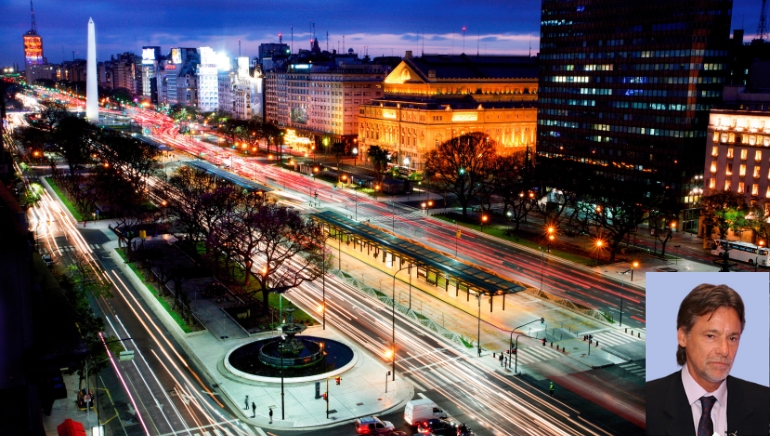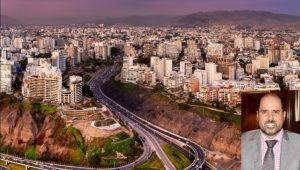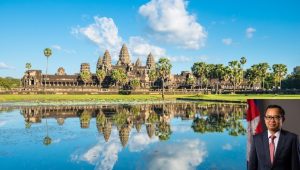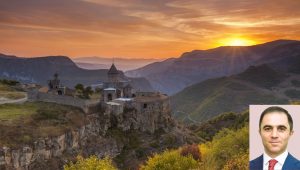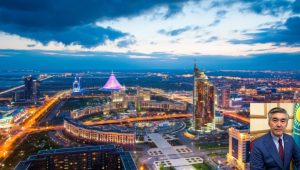With the memories of the World Cup still on, Argentina is known because of its football, but also for its delicious food, outstanding wines, incredible gastronomic offer, cultural richness and breathtaking landscapes! Located in the southern part of the American Continent, the country is the 8th largest in the world and the 2nd in the region. It is divided into 24 provinces, with six tourism regions well-developed by air and land infrastructure. It is a must-visit destination for those looking for an unforgettable experience while travelling solo, on business basis or with friends and family
By H.E. Mr. Daniel Quer Confalonieri, Consul General of the Argentine Republic in Mumbai, India
Argentina is blessed with diversity, contrast and heritage. The country was made by immigrants, which has created a mindset of welcoming foreigners, and is a melting pot that adapts and combines different cultures. Geographical diversity and climate contrast is the feature of the country: landscapes ranging from mountains, rivers and volcanoes to salt flats, arid soils and glaciers. It is a whole-year-round destination, which can be visited any time, as per the tourists’ convenience. Regarding world patrimony, we host 12 UNESCO declared World Heritage Sites, showing our aim to protect not only the tangible legacy but also the valuable national culture.
BUENOS AIRES REGION (BUENOS AIRES CITY AND BUENOS AIRES PROVINCE)
The city is usually considered the gateway to the country. It hosts renowned restaurants, iconic spots like the Obelisco and Plaza de Mayo Square, and outstanding architecture as the Barolo and San Martín Palaces. It is also the place for sport lovers, in particular those who love football and polo, with huge stadiums and competitive tournaments. Culture is always present at the museums, at “milongas” (tango dance halls), street art and special events that run almost every month. Even though the 48 neighborhoods deserve a visit, we would suggest this shortlist:
La Boca with Caminito that resembles the perfect combination of bright colours, football passion, tango devotion and Italian traditions;
San Telmo, one of the oldest neighborhoods, is a journey back in time with its cobblestone streets, antique market and the art of “fileteado” (stylised artistic drawings and lettering);
Recoleta, with its vibrant cultural life, historic cafes, monuments, must-seen spots like the cemetery – resting place of notable figures and personalities, the library El Ateneo Grand Splendid – a former theatre, nowadays one of the world’s most beautiful bookstores – and the renowned Opera House Colon Theater;
Puerto Madero, the newest part of the city, has been beautified by its river view sight, tall and modern towers and the Costanera Sur Ecological Reserve, a paradise for birdwatchers and those who admire our National flower, the Ceibo.
At short driving distance, Buenos Aires Province offers coastal Atlantic cities with lovely beaches like Mar del Plata, Villa Gesel and Pinamar, and unique deltas as the one located in Tigre. A day trip should not miss the experience of visiting the old rural houses called “estancias,” to enjoy our famous “asado” (barbecue which consists of beef cooked on an open grill) and the yerba mate which is our national infusion. A match of our national sport, called pato, can also be attended.
“WITH PRISTINE LAKES, BLUE SKIES & DREAMED VALLEYS; CÓRDOBA OFFERS LOCAL MUSIC & HERITAGE BUILDINGS”
CÓRDOBA REGION (CÓRDOBA)
Blessed with pristine rivers and lakes, blue and pure skies, and dreamed valleys and hills; Córdoba offers local music, culture and heritage buildings. The Jesuitic Block –that includes the first university of the country, built in the 17th century, and one of the oldest of the continent – together with the Jesuit Estancias (residences and farming estates) were declared UNESCO world heritage sites. Water sports, golf, horse riding and bird watching at the Quebrada del Condorito National Park, where condor birds can be seen, are advisable activities to be done. Attending and enjoying local festivals, like the famous “Festival de la Doma y el Folklore,” are also unique experiences. For those who like to enjoy scenic mountain landscapes, a visit to the Cerro Uritorco (Punilla Valley) will be memorable. Gastronomy is also a must: visitors should try the popular drink that combines the “Fernet” (bitter herbal spirit) with Cola.
CUYO (MENDOZA, SAN JUAN, AND SAN LUIS)
The Andes Range is not only known as an adventure spot, but also as an enotourism landmark. The Aconcagua mountain, the highest peak in the Americas, located within the same name provincial park, encourages mountaineers to climb and do trekking; while the wild rivers invite for rafting. Regarding wines, Mendoza is one of the World Wine Capitals and along with San Juan, the main wine producers and exporters of Argentina. Visitors can immerse themselves into marvelous experiences around the purple grapes of the Malbec: learning about the vineyards history, staying at exclusive hotels, and enjoying high end gastronomy and wine spas.
On another scope, at 2552 meters above sea level, El Leoncito National Park (San Juan) displays a spectacular location for astro tourism as it offers 365 days of star shows. At the Ischigualasto Provincial Park the astonishing-shaped rocks and the desert landscape feels like walking on the lunar surface, granting the place the nickname of “The Moon Valley.” The Natural Monument called “Inca Bridge” (Mendoza) is an extraordinary geological form, which used to be a part of the Inca network road called QhapaqÑan, a transnational UNESCO World Hertage Site.
LITORAL REGION (MISIONES, CORRIENTES, ENTRE RÍOS, FORMOSA, CHACO, AND SANTA FE)
The subtropical region is one of the most visited by international and national tourism, being a mix of subtropical weather, cultural heritage and natural wonders such as rainforests, rivers, waterfalls and hot springs. The Iguazú Falls (Misiones), with its impressive falls surrounded by a rainbow background and a flora and fauna colour blast, are a proof of nature at its most beautiful expression. Taller than Niagara and wider than Victoria, the Iguazú Falls are the result of a volcanic eruption that left a large crack in the earth. A protected world site, the National Park can be visited by a walk through the trails, riding the eco-train or, for adrenaline seekers, set sail inside the threatening Devil ́s Throat fall. The province hosts the Jessuitic Missions, also worldwide patrimony, which shows the guaranies (local population) ways of living.
Esteros del Iberá (Corrientes), the world ́s second largest wetland, and Bañado La Estrella (Formosa), the largest in South America, are also recommended must-seen spots, as well as the least explored National Park El Impenetrable (Chaco). These places bring the opportunity to observe in depth the native flora and fauna varieties, to interact with local populations and to enjoy a boat or kayak ride. Last but not least, Rosario (Santa Fe) is the city where football and history combines. The city where Lionel Messi was born and started to play football, it is also the place where the Argentine flag was firstly hoisted. Don ́t miss the monument honouring our national symbol, placed near the Paraná river.
NORTH (JUJUY, SALTA, TUCUMÁN, CATAMARCA, LA RIOJA AND SANTIAGO DEL ESTERO)
Known as the land of flavours and traditions, it also presents geographical contrasts: green, hot and humid Yungas (a bioregion of forest along the eastern slope of the Andes Mountains) combined with the aridity of the Puna (high land in Quechua aboriginal language), the salt flat whiteness, and the height of the volcanoes (being the “Ojos del Salado,” the world highest). The magical towns along the Quebrada de Humahuaca (Jujuy) can be explored by foot, horse or adventure vehicles. Villages like Purmamarca, one of the country ́s most beautiful and home to the Seven Colours Hills and the archeological pre-hispanic settlement of the Pucará Tilcara, deserves a visit. Salinas Grandes, on the other hand, invites to discover one of the world ́s largest salt flats at the astonished height of 3,400 metres. With its redish cliffs, Talampaya National Park (La Rioja) immerses tourists on a walk through the past. The colourful Carnaval and the celebrations to the mother earth, the Pachamama, along with the Train to the Clouds, one of the highest of the world, are such an experience. Llamas, alpacas, and flamingos welcome the visitors inspiring to taste the local dishes such as tamales, humitas and empanadas paired with the high-
altitude white wine (Torrontés). This varietal comes from the grapes harvested at Cafayate ́s highest vineyards (Salta).
PATAGONIA (LA PAMPA, NEUQUÉN, RÍO NEGRO, CHUBUT, SANTA CRUZ, AND TIERRA DEL FUEGO)
With average temperatures of 10oC and considered as The End of World, the region presents an extraordinary picture build up by the glaciers, on one side, and colourful tulipans, steppes and greenery forests, on the other. First declared world patrimony and one of the largest world water reserves, Los Glaciares National Park introduces to breathtaking landscapes. The Perito Moreno Glacier is the most visited and can be admired by walking through the trails or sailing around. Heading north, the Seven Route Lake provides the chance to take a drive through the mythic Route 40, between San Martín de los Andes and Villa La Angostura. The “Cueva de las manos” (Santa Cruz), an archeological world Heritage site, shows paintings of hunter-gatherer communities, while the light of the end of the world and the train are landmarks in Ushuaia (Tierra del Fuego). The port of the city is also the stop for those embarking to Antarctica. Close encounters and sightseeing with fantastic marine fauna like the Right Southern Whales, Magalleanic penguins, sea lions
and orcas, complete the magical experience. On the flora side, Los Alerces National Park (Chubut) protect the Larch trees and, in particular, one of the world oldest, nicknamed “The Grandpa.” Lastly, the gourmet high end Patagonian cuisine as well as the chocolates, deserve a try.





